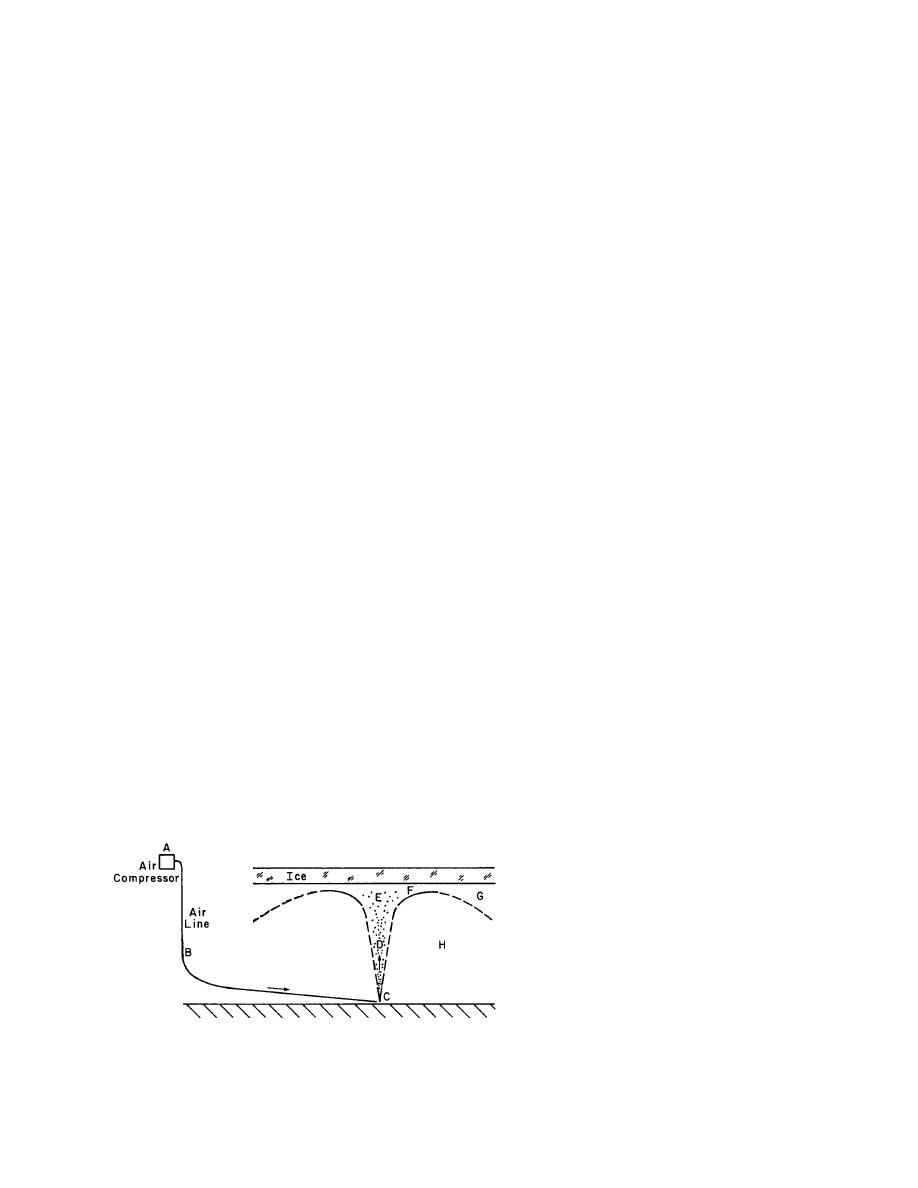
transfer or melting will occur, so it is the thermal
The vibration levels caused by a ship pas-
reserve in the water represented by above-freez-
sage with an ice cover were about four times
ing temperatures that allows the bubblers to work.
those without an ice cover; and
Other methods of inducing a current, such as a
The vibration levels with a solid ice cover
submerged motor-driven propeller or the natu-
and with a broken ice cover are about the
ral flow currents, will have the same effect. Bub-
same.
blers are generally chosen because they are con-
venient to install and operate, particularly if a
long narrow zone of ice suppression is desired,
ENGINEERING AND
since all that is required is to space orifices along
ENVIRONMENTAL EFFECTS
a diffuser line. Limitations to the use of bubblers
OF HEAT-TRANSFER
include limited thermal reserves in the water, limi-
BUBBLER SYSTEMS
tations on the zone of influence due to the rather
narrow zone of melting (rarely more than tens of
Air bubblers are systems used to induce melt-
feet), and their slow but persistent rate of action.
ing or retard the freezing of ice covers. Their use
They are particularly effective in local suppres-
in locally reducing the ice cover thickness in navi-
sion of ice as at slips or docks or in providing a
gation channels was investigated under the Winter
relief zone in an otherwise intact ice cover to al-
Navigation Demonstration Program. The principle
low easier vessel maneuvering in the adjacent ice
of operation is to release air at some depth below
cover.
the ice cover; the rising bubbles create an upward
current of water that impinges against and flows
along the underside of the ice cover. If the water
Environmental effects
There have been two sites at which environ-
is above freezing, this flow of water results in heat
mental effects of heat-transfer bubbler systems
transfer to the ice cover and causes melting. Both
have been intensely studied under the Great Lakes
point-source bubblers (one orifice releasing air)
Winter Navigation Program: at the DuluthSu-
or line-source bubblers (orifices spaced along a
perior Harbor area and in the St. Marys River.
line) are used.
There were many environmental concerns ad-
Figure 18 is a schematic of a bubbler system.
dressed in these studies, but they may be sum-
A compressor at point A delivers air into a sup-
marized under three main subjects: effects on fish
ply line B. The air flows through the diffuser line
movement and population, effects on sediment
C and is discharged through very small orifices
resuspension, and changes in water quality.
distributed along the length of the diffuser. The
A number of studies assessed the possible ef-
rising bubbler streams (region D) entrain water,
fects on fish movement and populations. Behmer
creating a rising plume of water that impinges
and Gleason (1975) recorded fish movements at
against the ice cover (region E), and this plume
the edge of the shipping channel of the St. Marys
spreads and flows beneath the ice cover (region
River and Whitefish Bay. Dahlberg et al. (1980)
F), where it transfers heat to the underside, then
also prepared two annotated bibliographies, at-
gradually dissipates (region G).
tached to their report, on ecological effects of air
The cause of the melting is the "wiping" of
bubblers and on winter fish and macrobenthos
the warm water against the ice, and the only pur-
communities. Both reports should be consulted
pose of the air bubbling is to induce this current.
If the water is at the freezing point of 0C, no heat
for details but the general findings were that the
proposed bubbler systems would not have
an adverse effect on the aquatic biota in
winter. Bubbler systems similar to those pro-
posed for navigation aids have been con-
sidered as a means of preventing fish from
entering intakes and generally found to be
ineffective. The less intense bubbler systems
used for ice suppression are similarly inef-
fective; fish movement appears to be un-
impeded by the bubble streams and asso-
ciated currents, which are widely spaced
Figure 18. Schematic of a bubbler system.
relative to their diameters.
38



 Previous Page
Previous Page
